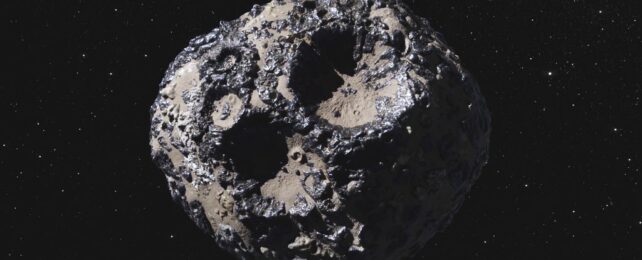The densest naturally occurring element on the periodic table is the metal osmium. At room temperature, it forms a solid with a density of 22.59 grams per cubic centimeter – nearly twice as dense as Earth's inner core and almost as dense as the core of Jupiter.
But there are some objects out there in the Solar System that seem to be way more dense than osmium; not even planetary cores, but asteroids, which don't have the mass to compress minerals into an ultradense state.
This has led scientists to speculate that there are naturally occurring, stable elements out there beyond the periodic table – even beyond the unstable, radioactive superheavy elements between atomic numbers 105 and 118, which have only ever been observed in laboratory settings.
It's unknown whether elements with more than 118 protons would even be stable – they've certainly never been observed, either in the wild or in laboratory settings. But theoretical work suggests that there's an island of stability around atomic number 164, where superheavy elements eould not be as prone to radioactive decay and may stick around, at least for a time.
Because these heavier elements are expected to be denser, they could explain peculiar observations involving the asteroid 33 Polyhymnia, a rock in the asteroid belt that measures roughly 50 to 60 kilometers (around 30 to 36 miles) across. One measurement has derived a density for 33 Polyhymnia of 75.28 grams per cubic centimeter, classifying it as a potential compact ultradense object (CUDO).
An outlier that extreme is likely to be the result of an erroneous measurement. Even the astronomer who made that calculation noted it was unrealistic.
But physicists Evan LaForge, Will Price and Johann Rafelski of the University of Arizona wanted to investigate whether or not such a density was at least physically plausible.
They based their work on a model of the atom called the Thomas-Fermi model, known to be a crude but useful way to form basic approximations of certain atomic behaviors. Under this framework, the researchers investigated the atomic structure of hypothetical superheavy elements.
"We chose this model, despite its relative imprecision, because it allows the systematic exploration of atomic behavior as a function of atomic number beyond the known periodic table," Rafelski says.
"A further consideration is that it also enabled us to explore many atoms in the short time available to Evan [LaForge], our brilliant undergraduate student."
Their calculations agreed with the island of stability previously predicted to reside at atomic number 164. And they showed that the density range of this element sits between 36 and 68.4 grams per cubic centimeter. That's close to that high density calculation for 33 Polyhymnia.
That doesn't mean that 33 Polyhymnia is ultradense. It just means that there could be an explanation for that (possibly erroneous) measurement of ultradensity that doesn't require reaching into the mystery matter basket.
"The purpose of this study was to determine whether CUDOs with extreme mass density could be achieved without the need for the usually invoked strange or dark matter," the researchers write in their paper.
"We have done this while exploring two different nuclear systems using the relativistic Thomas-Fermi model. From the exploration of both standard nuclei and alpha matter, it is clear that both types of nuclear matter could explain the density seen in CUDOs such as asteroid 33 Polyhymnia."
The work, they say, demonstrates the utility of the Thomas-Fermi model for probing the properties of hypothetical superheavy elements, and provides the groundwork for more robust analyses thereof.
The research appears in The European Physical Journal Plus.
